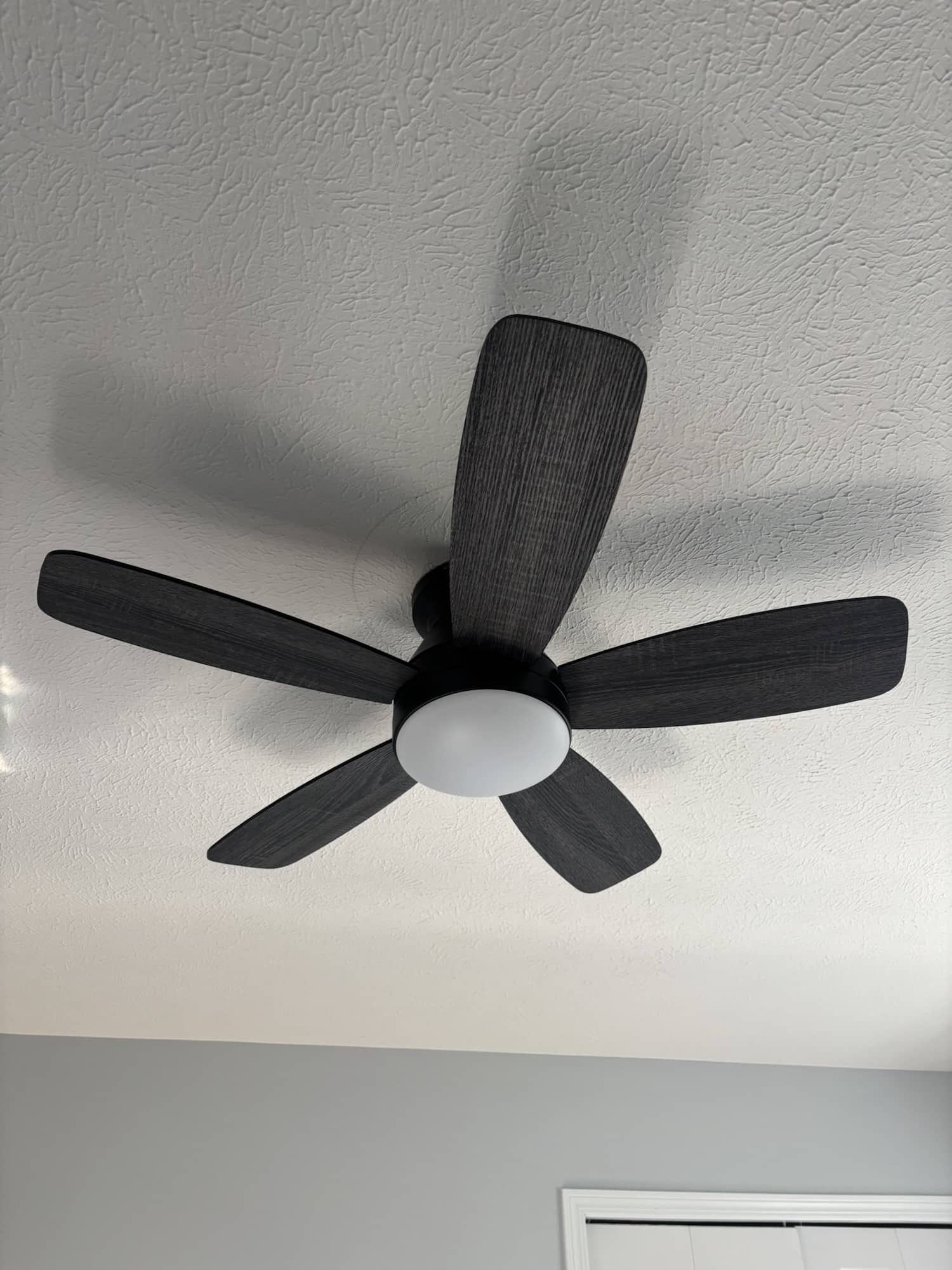

Fan size matters more than people think. A fan that’s too small won’t move enough air, and one that’s too big can create drafts or wobble.
Quick refresher: To find your room’s square footage, just measure the length × width.
For example, a 10×12 bedroom = 120 square feet.
General sizing guide:
Small rooms (up to 100 sq ft): 36–42 inches
Medium rooms (100–250 sq ft): 44–52 inches
Large rooms (250–400 sq ft): 56–60 inches or more
The sweet spot for airflow and safety is when the blades sit about 8–9 feet above the floor.
For 8-foot ceilings, choose a flush-mount (hugger) fan so you maintain head clearance.
For higher ceilings, add a downrod — usually 6–12 inches long — to bring the fan closer to where you actually feel the breeze.
If your ceiling is vaulted or angled, you’ll likely need a special mounting bracket to keep the fan level. We carry adjustable brackets that allow the fan to hang correctly even on steep ceilings.
Pro tip: Always check that there’s at least 7 feet of clearance between the floor and the lowest blade to meet building code and prevent accidents — and be sure to give your tall friends a heads-up before they walk in. No free haircuts here.
Read More: Proper Height For a Ceiling Fan Makes a Big Difference
You might notice when shopping for ceiling fans that some list AC motors and others use DC motors. Both are solid options — they just work a little differently.
AC (alternating current) motors are the classic choice found in most older homes. They’re affordable, easy to wire into existing light switches, and get the job done without any fancy tech.
DC (direct current) motors are newer and a bit more efficient — they use up to 70% less energy, run quieter, and usually come with a remote or smart control. They do cost more upfront, but they’re a great choice if you plan to stay in your home long-term and want the lowest possible energy use and sound.
Pro tip: DC fans are so quiet you might double-check they’re running. They also reverse direction at the push of a button, so you can use them for both cooling and warming without climbing a ladder.
When you start comparing ceiling fans, you’ll notice some have 3 blades, some have 5, and some look like they belong in an airplane hangar. The truth is — blade count doesn’t affect airflow as much as you might think.
The motor and the pitch (the angle of the blades) do most of the heavy lifting when it comes to moving air. Blade count mostly changes how the fan looks and sounds.
3-blade fans have a modern, sleek style and move air fast — great for large, open spaces where you don’t mind a little wind noise.
4–5 blades give a balanced mix of quiet and efficiency — perfect for bedrooms, living rooms, and most Cleveland homes.
6+ blades are mainly for looks or oversized areas, and can actually move less air due to added drag.
Every ceiling and room layout is a little different, and the right fan type depends on how much height, slope, or open space you’re working with. Picking the right mount keeps your fan safe, effective, and looking like it belongs there — not like it’s hanging on for dear life.
Here’s a quick breakdown:
Standard mount: Best for 8–10 ft ceilings in most bedrooms and living rooms.
Low-profile (hugger) fans: Great for shorter ceilings where every inch of clearance matters.
Downrod fans: Perfect for vaulted or high ceilings — the rod lowers the fan so you actually feel the airflow where you live, not up near the rafters.
Dual-motor or large-span fans: Ideal for open floor plans, garages, or long rooms that need more coverage.
Pro tip: In older Cleveland homes, the ceiling box for a light fixture often isn’t rated to hold a fan’s weight or movement. We’ll inspect your box before installation and replace it with a fan-rated one if needed — no surprises, no wobble, no “hope it holds” moments.
Today’s fans can do much more than spin. Smart models connect to Wi-Fi or voice assistants, remotes add convenience, and reversible settings let you push heat down in winter. Look for Energy Star ratings and variable-speed options for quieter, more efficient performance.
Pro tip: Smart fans are perfect if you already talk to your lights — might as well invite your fan into the conversation.
Learn more
Fans can provide airflow, light, or both. Integrated LED kits offer bright, efficient lighting, while fan-only models keep the look clean. Choose warm light (2700–3000 K) for bedrooms and cooler tones (4000 K+) for work areas.
Pro tip: We can wire fans to separate switches or dimmers so you can control light and airflow independently.
Learn more

Whether your old fan wobbles, hums, or just doesn’t move enough air anymore — we can help. At Colin Can Help, we install, replace, and fix ceiling fans for homeowners across Northeast Ohio who want better comfort, cleaner air, and a safer, more balanced home.
Ceiling fans aren’t just a finishing touch — they’re one of the simplest ways to make your space feel better in every season. From circulating cool air in July to pushing warmth down in January, a properly installed ceiling fan keeps rooms comfortable while cutting down on energy costs.
We take care of everything — from safe wiring and secure mounting to balancing, testing, and cleanup — so your new fan looks great, runs smooth, and lasts for years.
Not all ceiling fans are built the same. The right fan for a small bedroom won’t perform the same in an open living room or on a covered patio. When we help homeowners across Northeast Ohio choose new fans, we focus on three things: size, type, and location. Get these right, and your fan will move air efficiently, stay quiet, and look like it was meant to be there.



Beachwood
Cleveland Heights
Euclid
Lyndhurst
Richmond Heights
Mayfield
Mayfield Heights
Mayfield Villiage
South Euclid
University Heights
Willoughby Hills
Wickliffe
Willowick